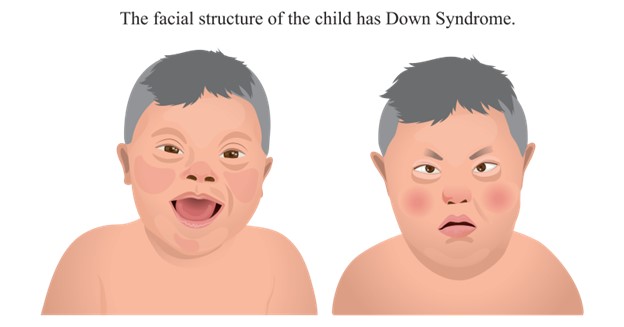While talking with a pregnant woman who has undergone genetic testing, the woman informs the nurse that her baby will be born with Down syndrome. The nurse understands that Down syndrome is an example of:
Trisomy numeric abnormality
Multifactorial inheritance
X-linked recessive inheritance
Chromosomal deletion
The Correct Answer is A
Choice A Reason: Trisomy numeric abnormality. Down syndrome is a genetic disorder that occurs when a person has three copies of chromosome 21 instead of two. This extra chromosome causes various physical and mental features that vary from person to person. Down syndrome is also called trisomy 21 because it involves three copies of chromosome 21.
Choice B Reason: Multifactorial inheritance is incorrect because it refers to a type of genetic disorder that results from the interaction of multiple genes and environmental factors. Examples of multifactorial disorders include cleft lip or palate, neural tube defects, diabetes, hypertension, and some types of cancer.
Choice C Reason: X-linked recessive inheritance is incorrect because it refers to a type of genetic disorder that affects males more than females because it is caused by a mutation on the X chromosome. Females have two X chromosomes, so they can be carriers or affected depending on whether they inherit one or two copies of the mutated gene. Males have one X chromosome and one Y chromosome, so they are always affected if they inherit the mutated gene from their mother. Examples of X-linked recessive disorders include hemophilia, color blindness, and Duchenne muscular dystrophy.
Choice D Reason: Chromosomal deletion is incorrect because it refers to a type of genetic disorder that occurs when a part of a chromosome is missing or deleted. This can cause various physical and mental problems depending on the size and location of the deletion. Examples of chromosomal deletion

Nursing Test Bank
Naxlex Comprehensive Predictor Exams
Related Questions
Correct Answer is ["A","B","D"]
Explanation
Choice A Reason: This is correct because breast tenderness is a common discomfort during the first trimester of pregnancy. It is caused by hormonal changes that stimulate breast growth and prepare them for lactation. Breast tenderness may also be accompanied by swelling, tingling, or sensitivity.
Choice B Reason: This is correct because urinary frequency is a common discomfort during the first trimester of pregnancy. It is caused by hormonal changes that increase blood flow to the kidneys and bladder, as well as by the growing uterus that puts pressure on the bladder. Urinary frequency may also be associated with increased thirst or urinary tract infections.
Choice C Reason: This is incorrect because backache is not a common discomfort during the first trimester of pregnancy. It usually occurs in later stages of pregnancy, when the weight of the fetus and the uterus shifts the center of gravity and strains the back muscles and ligaments. Backache may also be caused by poor posture, stress, or fatigue.
Choice D Reason: This is correct because cravings are a common discomfort during the first trimester of pregnancy. They are caused by hormonal changes that affect the sense of taste and smell, as well as by emotional or psychological factors. Cravings may vary from person to person and may include foods that are sweet, salty, sour, or spicy.
Choice E Reason: This is incorrect because leg cramps are not a common discomfort during the first trimester of pregnancy. They usually occur in later stages of pregnancy, when there is increased pressure on the nerves and blood vessels that supply the legs. Leg cramps may also be caused by dehydration, electrolyte imbalance, or muscle fatigue.
Correct Answer is ["31"]
Explanation
The correct answer is 31 gtts/min. To calculate the infusion rate, the nurse should use the following formula:
Infusion rate (gtts/min) = Volume (mL) x Drop factor (gtts/mL) / Time (min)
Plugging in the given values, we get:
Infusion rate (gtts/min) = 1000 mL x 15 gtts/mL / 480 min
Infusion rate (gtts/min) = 31.25 gtts/min
Rounding to the nearest whole number, we get 31 gtts/min.
Whether you are a student looking to ace your exams or a practicing nurse seeking to enhance your expertise , our nursing education contents will empower you with the confidence and competence to make a difference in the lives of patients and become a respected leader in the healthcare field.
Visit Naxlex, invest in your future and unlock endless possibilities with our unparalleled nursing education contents today
Report Wrong Answer on the Current Question
Do you disagree with the answer? If yes, what is your expected answer? Explain.
Kindly be descriptive with the issue you are facing.
